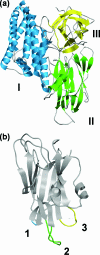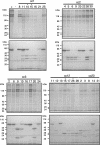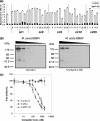Investigating the properties of Bacillus thuringiensis Cry proteins with novel loop replacements created using combinatorial molecular biology
- PMID: 18408065
- PMCID: PMC2423019
- DOI: 10.1128/AEM.02844-07
Investigating the properties of Bacillus thuringiensis Cry proteins with novel loop replacements created using combinatorial molecular biology
Abstract
Cry proteins are a large family of crystalline toxins produced by Bacillus thuringiensis. Individually, the family members are highly specific, but collectively, they target a diverse range of insects and nematodes. Domain II of the toxins is important for target specificity, and three loops at its apex have been studied extensively. There is considerable interest in determining whether modifications in this region may lead to toxins with novel specificity or potency. In this work, we studied the effect of loop substitution on toxin stability and specificity. For this purpose, sequences derived from antibody complementarity-determining regions (CDR) were used to replace native domain II apical loops to create "Crybodies." Each apical loop was substituted either individually or in combination with a library of third heavy-chain CDR (CDR-H3) sequences to create seven distinct Crybody types. An analysis of variants from each library indicated that the Cry1Aa framework can tolerate considerable sequence diversity at all loop positions but that some sequence combinations negatively affect structural stability and protease sensitivity. CDR-H3 substitution showed that loop position was an important determinant of insect toxicity: loop 2 was essential for activity, whereas the effects of substitutions at loop 1 and loop 3 were sequence dependent. Unexpectedly, differences in toxicity did not correlate with binding to cadherins--a major class of toxin receptors--since all Crybodies retained binding specificity. Collectively, these results serve to better define the role of the domain II apical loops as determinants of specificity and establish guidelines for their modification.
Figures









Similar articles
-
Mutations in domain I interhelical loops affect the rate of pore formation by the Bacillus thuringiensis Cry1Aa toxin in insect midgut brush border membrane vesicles.Appl Environ Microbiol. 2009 Jun;75(12):3842-50. doi: 10.1128/AEM.02924-08. Epub 2009 Apr 17. Appl Environ Microbiol. 2009. PMID: 19376918 Free PMC article.
-
Using phage display technology to obtain Crybodies active against non-target insects.Sci Rep. 2017 Nov 2;7(1):14922. doi: 10.1038/s41598-017-09384-x. Sci Rep. 2017. PMID: 29097681 Free PMC article.
-
Novel Bacillus thuringiensis δ-endotoxin active against Locusta migratoria manilensis.Appl Environ Microbiol. 2011 May;77(10):3227-33. doi: 10.1128/AEM.02462-10. Epub 2011 Mar 25. Appl Environ Microbiol. 2011. PMID: 21441319 Free PMC article.
-
Structural insights into Bacillus thuringiensis Cry, Cyt and parasporin toxins.Toxins (Basel). 2014 Sep 16;6(9):2732-70. doi: 10.3390/toxins6092732. Toxins (Basel). 2014. PMID: 25229189 Free PMC article. Review.
-
Bt toxin modification for enhanced efficacy.Toxins (Basel). 2014 Oct 22;6(10):3005-27. doi: 10.3390/toxins6103005. Toxins (Basel). 2014. PMID: 25340556 Free PMC article. Review.
Cited by
-
Cry1Aa binding to the cadherin receptor does not require conserved amino acid sequences in the domain II loops.Biosci Rep. 2012 Dec 20;33(1):103-12. doi: 10.1042/BSR20120113. Biosci Rep. 2012. PMID: 23145814 Free PMC article.
-
Improved insecticidal toxicity by fusing Cry1Ac of Bacillus thuringiensis with Av3 of Anemonia viridis.Curr Microbiol. 2014 May;68(5):604-9. doi: 10.1007/s00284-013-0516-1. Epub 2013 Dec 29. Curr Microbiol. 2014. PMID: 24375189
-
Biotoxicity assessment of cloned cry 11 protein gene from Bacillus thuringiensis 9NF.Saudi J Biol Sci. 2022 Nov;29(11):103463. doi: 10.1016/j.sjbs.2022.103463. Epub 2022 Sep 27. Saudi J Biol Sci. 2022. PMID: 36263005 Free PMC article.
-
Affinity maturation of Cry1Aa toxin to the Bombyx mori cadherin-like receptor by directed evolution based on phage display and biopanning selections of domain II loop 2 mutant toxins.Microbiologyopen. 2014 Aug;3(4):568-77. doi: 10.1002/mbo3.188. Epub 2014 Jul 16. Microbiologyopen. 2014. PMID: 25044375 Free PMC article.
-
Making 3D-Cry Toxin Mutants: Much More Than a Tool of Understanding Toxins Mechanism of Action.Toxins (Basel). 2020 Sep 16;12(9):600. doi: 10.3390/toxins12090600. Toxins (Basel). 2020. PMID: 32948025 Free PMC article. Review.
References
-
- Bell, R. A., and F. G. Joachim. 1976. Techniques for rearing laboratory colonies of tobacco hornworms and pink bollworms. Ann. Entomol. Soc. Am. 69:365-373.
-
- Binz, H. K., P. Amstutz, and A. Pluckthun. 2005. Engineering novel binding proteins from nonimmunoglobulin domains. Nat. Biotechnol. 23:1257-1268. - PubMed
-
- Binz, H. K., and A. Pluckthun. 2005. Engineered proteins as specific binding reagents. Curr. Opin. Biotechnol. 16:459-469. - PubMed
Publication types
MeSH terms
Substances
LinkOut - more resources
Full Text Sources
Other Literature Sources
Miscellaneous

